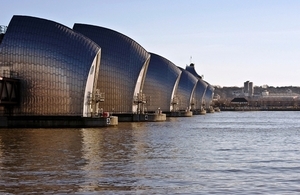Thames Barrier visit for Climate Change Secretary on World Environment Day
Energy and Climate Change Secretary Amber Rudd marks World Environment Day by visiting the Thames Barrier, which is crucial to protecting our environment and offers protection from the impact of climate change.

The Thames Barrier. Credit: iStock by Getty Images
The Energy and Climate Change Secretary Amber Rudd today chose to mark World Environment Day by visiting the Thames Barrier, which is crucial to protecting our environment and offers protection from the impact of climate change. The visit is Amber Rudd’s first as Energy and Climate Change Secretary.
The barrier has been enormously successful and protects 125 square kilometres of central London from storm surges, but rising sea levels as a result of climate change is increasing the risk these surges will become larger and more damaging.
Amber Rudd said:
The Thames Barrier is an iconic part of London’s landscape and one of our best protections. But barriers like this can only do so much – the world must act now to cut emissions and build a cleaner future, and this year World Environment Day is more important than ever to focus minds ahead of this year’s crunch climate talks in Paris.
We need to take urgent and concrete action to protect our environment – because our lives and livelihoods depend on it. That’s why I’m pushing for a strong global deal in Paris – that will give certainty for businesses and investors to put the world on a low carbon path as we grow our economies and make people around the world more prosperous.
The Thames Barrier spans 520 metres across the river Thames near Woolwich, and has 10 steel gates that can be raised into position to protect London from storm surges.
When raised, the main gates stand as high as a 5-storey building and as wide as the opening of Tower Bridge. Each main gate weighs 3,300 tonnes.
While visiting, Amber Rudd met with Environment Agency representatives who operate the barrier, and discussed the current challenges as well as the future of the project in the context of the Thames Estuary 2100 initiative.
World Environment Day is one of the key UN initiatives for encouraging awareness and action for the environment worldwide.
This year it has particular significance in the run up to a major conference in Paris where the UN will negotiate a global deal to keep limiting global warming to 2 degrees within reach. The UK is leading on pushing for an ambitious deal and has achieved a lot at home too. We have already reduced our emissions by 30% from 1990 levels and have championed national carbon emission cuts across the EU of at least 40% by 2030.
We’ve seen amazing advances in technology in the last decade and Britain is at the forefront of developing low-energy, clean technologies such as offshore wind.
Just today ScottishPower Renewables and Siemens agreed one of the UK’s largest manufacturing renewable energy deals of £800 million to build wind turbines for the East Anglia ONE offshore wind farm, creating thousands or jobs across the UK and particularly in Hull where the turbines will be built.
Commenting on the deal, Amber Rudd said:
This massive financial investment is great news for East Anglia and for Hull, which will now become a real clean energy manufacturing hub.
In addition to supporting thousands of UK jobs, this project shows we are driving down the costs of offshore wind; another demonstration of how the Government is developing the full potential of the offshore wind sector at the lowest cost to bill payers.